Subsections of Integrations
AIKit
GitHub Link - https://github.com/sozercan/aikit
AIKit is a quick, easy, and local or cloud-agnostic way to get started to host and deploy large language models (LLMs) for inference. No GPU, internet access or additional tools are needed to get started except for Docker!
AIKit uses LocalAI under-the-hood to run inference. LocalAI provides a drop-in replacement REST API that is OpenAI API compatible, so you can use any OpenAI API compatible client, such as Kubectl AI, Chatbot-UI and many more, to send requests to open-source LLMs powered by AIKit!
At this time, AIKit is tested with LocalAI llama backend. Other backends may work but are not tested. Please open an issue if you’d like to see support for other backends.
Features
- 🐳 No GPU, Internet access or additional tools needed except for Docker!
- 🤏 Minimal image size, resulting in less vulnerabilities and smaller attack surface with a custom distroless-based image
- 🚀 Easy to use declarative configuration
- ✨ OpenAI API compatible to use with any OpenAI API compatible client
- 🚢 Kubernetes deployment ready
- 📦 Supports multiple models with a single image
- 🖥️ Supports GPU-accelerated inferencing with NVIDIA GPUs
- 🔐 Signed images for
aikit and pre-made models
Pre-made Models
AIKit comes with pre-made models that you can use out-of-the-box!
CPU
- 🦙 Llama 2 7B Chat:
ghcr.io/sozercan/llama2:7b
- 🦙 Llama 2 13B Chat:
ghcr.io/sozercan/llama2:13b
- 🐬 Orca 2 13B:
ghcr.io/sozercan/orca2:13b
NVIDIA CUDA
- 🦙 Llama 2 7B Chat (CUDA):
ghcr.io/sozercan/llama2:7b-cuda
- 🦙 Llama 2 13B Chat (CUDA):
ghcr.io/sozercan/llama2:13b-cuda
- 🐬 Orca 2 13B (CUDA):
ghcr.io/sozercan/orca2:13b-cuda
CUDA models includes CUDA v12. They are used with NVIDIA GPU acceleration.
Quick Start
Creating an image
This section shows how to create a custom image with models of your choosing. If you want to use one of the pre-made models, skip to running models.
Please see models folder for pre-made model definitions. You can find more model examples at go-skynet/model-gallery.
Create an aikitfile.yaml with the following structure:
#syntax=ghcr.io/sozercan/aikit:latest
apiVersion: v1alpha1
models:
- name: llama-2-7b-chat
source: https://huggingface.co/TheBloke/Llama-2-7B-Chat-GGUF/resolve/main/llama-2-7b-chat.Q4_K_M.gguf
This is the simplest way to get started to build an image. For full aikitfile specification, see specs.
First, create a buildx buildkit instance. Alternatively, if you are using Docker v24 with containerd image store enabled, you can skip this step.
docker buildx create --use --name aikit-builder
Then build your image with:
docker buildx build . -t my-model -f aikitfile.yaml --load
This will build a local container image with your model(s). You can see the image with:
docker images
REPOSITORY TAG IMAGE ID CREATED SIZE
my-model latest e7b7c5a4a2cb About an hour ago 5.51GB
Running models
You can start the inferencing server for your models with:
# for pre-made models, replace "my-model" with the image name
docker run -d --rm -p 8080:8080 my-model
You can then send requests to localhost:8080 to run inference from your models. For example:
curl http://localhost:8080/v1/chat/completions -H "Content-Type: application/json" -d '{
"model": "llama-2-7b-chat",
"messages": [{"role": "user", "content": "explain kubernetes in a sentence"}]
}'
{"created":1701236489,"object":"chat.completion","id":"dd1ff40b-31a7-4418-9e32-42151ab6875a","model":"llama-2-7b-chat","choices":[{"index":0,"finish_reason":"stop","message":{"role":"assistant","content":"\nKubernetes is a container orchestration system that automates the deployment, scaling, and management of containerized applications in a microservices architecture."}}],"usage":{"prompt_tokens":0,"completion_tokens":0,"total_tokens":0}}
Kubernetes Deployment
It is easy to get started to deploy your models to Kubernetes!
Make sure you have a Kubernetes cluster running and kubectl is configured to talk to it, and your model images are accessible from the cluster.
You can use kind to create a local Kubernetes cluster for testing purposes.
# create a deployment
# for pre-made models, replace "my-model" with the image name
kubectl create deployment my-llm-deployment --image=my-model
# expose it as a service
kubectl expose deployment my-llm-deployment --port=8080 --target-port=8080 --name=my-llm-service
# easy to scale up and down as needed
kubectl scale deployment my-llm-deployment --replicas=3
# port-forward for testing locally
kubectl port-forward service/my-llm-service 8080:8080
# send requests to your model
curl http://localhost:8080/v1/chat/completions -H "Content-Type: application/json" -d '{
"model": "llama-2-7b-chat",
"messages": [{"role": "user", "content": "explain kubernetes in a sentence"}]
}'
{"created":1701236489,"object":"chat.completion","id":"dd1ff40b-31a7-4418-9e32-42151ab6875a","model":"llama-2-7b-chat","choices":[{"index":0,"finish_reason":"stop","message":{"role":"assistant","content":"\nKubernetes is a container orchestration system that automates the deployment, scaling, and management of containerized applications in a microservices architecture."}}],"usage":{"prompt_tokens":0,"completion_tokens":0,"total_tokens":0}}
For an example Kubernetes deployment and service YAML, see kubernetes folder. Please note that these are examples, you may need to customize them (such as properly configured resource requests and limits) based on your needs.
GPU Acceleration Support
At this time, only NVIDIA GPU acceleration is supported. Please open an issue if you’d like to see support for other GPU vendors.
NVIDIA
AIKit supports GPU accelerated inferencing with NVIDIA Container Toolkit. You must also have NVIDIA Drivers installed on your host machine.
For Kubernetes, NVIDIA GPU Operator provides a streamlined way to install the NVIDIA drivers and container toolkit to configure your cluster to use GPUs.
To get started with GPU-accelerated inferencing, make sure to set the following in your aikitfile and build your model.
runtime: cuda # use NVIDIA CUDA runtime
f16: true # use float16 precision
gpu_layers: 35 # number of layers to offload to GPU
low_vram: true # for devices with low VRAM
Make sure to customize these values based on your model and GPU specs.
After building the model, you can run it with --gpus all flag to enable GPU support:
# for pre-made models, replace "my-model" with the image name
docker run --rm --gpus all -p 8080:8080 my-model
If GPU acceleration is working, you’ll see output that is similar to following in the debug logs:
5:32AM DBG GRPC(llama-2-7b-chat.Q4_K_M.gguf-127.0.0.1:43735): stderr ggml_init_cublas: found 1 CUDA devices:
5:32AM DBG GRPC(llama-2-7b-chat.Q4_K_M.gguf-127.0.0.1:43735): stderr Device 0: Tesla T4, compute capability 7.5
...
5:32AM DBG GRPC(llama-2-7b-chat.Q4_K_M.gguf-127.0.0.1:43735): stderr llm_load_tensors: using CUDA for GPU acceleration
5:32AM DBG GRPC(llama-2-7b-chat.Q4_K_M.gguf-127.0.0.1:43735): stderr llm_load_tensors: mem required = 70.41 MB (+ 2048.00 MB per state)
5:32AM DBG GRPC(llama-2-7b-chat.Q4_K_M.gguf-127.0.0.1:43735): stderr llm_load_tensors: offloading 32 repeating layers to GPU
5:32AM DBG GRPC(llama-2-7b-chat.Q4_K_M.gguf-127.0.0.1:43735): stderr llm_load_tensors: offloading non-repeating layers to GPU
5:32AM DBG GRPC(llama-2-7b-chat.Q4_K_M.gguf-127.0.0.1:43735): stderr llm_load_tensors: offloading v cache to GPU
5:32AM DBG GRPC(llama-2-7b-chat.Q4_K_M.gguf-127.0.0.1:43735): stderr llm_load_tensors: offloading k cache to GPU
5:32AM DBG GRPC(llama-2-7b-chat.Q4_K_M.gguf-127.0.0.1:43735): stderr llm_load_tensors: offloaded 35/35 layers to GPU
5:32AM DBG GRPC(llama-2-7b-chat.Q4_K_M.gguf-127.0.0.1:43735): stderr llm_load_tensors: VRAM used: 5869 MB
AnythingLLM
AnythingLLM is an open source ChatGPT equivalent tool for chatting with documents and more in a secure environment by Mintplex Labs Inc.


⭐ Star on Github - https://github.com/Mintplex-Labs/anything-llm
- Chat with your LocalAI models (or hosted models like OpenAi, Anthropic, and Azure)
- Embed documents (txt, pdf, json, and more) using your LocalAI Sentence Transformers
- Select any vector database you want (Chroma, Pinecone, qDrant, Weaviate ) or use the embedded on-instance vector database (LanceDB)
- Supports single or multi-user tenancy with built-in permissions
- Full developer API
- Locally running SQLite db for minimal setup.
AnythingLLM is a fully transparent tool to deliver a customized, white-label ChatGPT equivalent experience using only the models and services you or your organization are comfortable using.
Why AnythingLLM?
AnythingLLM aims to enable you to quickly and comfortably get a ChatGPT equivalent experience using your proprietary documents for your organization with zero compromise on security or comfort.
What does AnythingLLM include?
- Full UI
- Full admin console and panel for managing users, chats, model selection, vector db connection, and embedder selection
- Multi-user support and logins
- Supports both desktop and mobile view ports
- Built in vector database where no data leaves your instance at all
- Docker support
Install
Local via docker
Running via docker and integrating with your LocalAI instance is a breeze.
First, pull in the latest AnythingLLM Docker image
docker pull mintplexlabs/anythingllm:master
Next, run the image on a container exposing port 3001.
docker run -d -p 3001:3001 mintplexlabs/anythingllm:master
Now open http://localhost:3001 and you will start on-boarding for setting up your AnythingLLM instance to your comfort level
Integration with your LocalAI instance.
There are two areas where you can leverage your models loaded into LocalAI - LLM and Embedding. Any LLM models should be ready to run a chat completion.
LLM model selection
During onboarding and from the sidebar setting you can select LocalAI as your LLM. Here you can set both the model and token limit of the specific model. The dropdown will automatically populate once your url is set.
The URL should look like http://localhost:8000/v1 or wherever your LocalAI instance is being served from. Non-localhost URLs are permitted if hosting LocalAI on cloud services.


LLM embedding model selection
During onboarding and from the sidebar setting you can select LocalAI as your preferred embedding engine. This model will be the model used when you upload any kind of document via AnythingLLM. Here you can set the model from available models via the LocalAI API. The dropdown will automatically populate once your url is set.
The URL should look like http://localhost:8000/v1 or wherever your LocalAI instance is being served from. Non-localhost URLs are permitted if hosting LocalAI on cloud services.


AutoGPT4all
AutoGPT4All provides you with both bash and python scripts to set up and configure AutoGPT running with the GPT4All model on the LocalAI server. This setup allows you to run queries against an open-source licensed model without any limits, completely free and offline.


Github Link - https://github.com/aorumbayev/autogpt4all
🚀 Quickstart
Using Bash Script:
git clone https://github.com/aorumbayev/autogpt4all.git
cd autogpt4all
chmod +x autogpt4all.sh
./autogpt4all.sh
Using Python Script:
Make sure you have Python installed on your machine.
git clone https://github.com/aorumbayev/autogpt4all.git
cd autogpt4all
python autogpt4all.py
❗️ Please note this script has been primarily tested on MacOS with an M1 processor. It should work on Linux and Windows, but it has not been thoroughly tested on these platforms. If not on MacOS install git, go and make before running the script.
🎛️ Script Options
For the bash script:
--custom_model_url - Specify a custom URL for the model download step. By default, the script will use https://gpt4all.io/models/ggml-gpt4all-l13b-snoozy.bin.
Example:
./autogpt4all.sh --custom_model_url "https://example.com/path/to/model.bin"
--uninstall - Uninstall the projects from your local machine by deleting the LocalAI and Auto-GPT directories.
Example:
./autogpt4all.sh --uninstall
To recap the commands, a –help flag is also available for the bash script.
For the Python Script:
You can use similar options as the bash script:
--custom_model_url - Specify a custom URL for the model download step.
Example:
python autogpt4all.py --custom_model_url "https://example.com/path/to/model.bin"
--uninstall - Uninstall the projects from your local machine.
Example:
python autogpt4all.py --uninstall
BionicGPT
an on-premise replacement for ChatGPT, offering the advantages of Generative AI while maintaining strict data confidentiality, BionicGPT can run on your laptop or scale into the data center.


BionicGPT Homepage - https://bionic-gpt.com
Github link - https://github.com/purton-tech/bionicgpt
Try it out
Cut and paste the following into a docker-compose.yaml file and run docker-compose up -d access the user interface on http://localhost:7800/auth/sign_up
This has been tested on an AMD 2700x with 16GB of ram. The included ggml-gpt4all-j model runs on CPU only.
Warning - The images in this docker-compose are large due to having the model weights pre-loaded for convenience.
services:
# LocalAI with pre-loaded ggml-gpt4all-j
local-ai:
image: ghcr.io/purton-tech/bionicgpt-model-api:llama-2-7b-chat
# Handles parsing of multiple documents types.
unstructured:
image: downloads.unstructured.io/unstructured-io/unstructured-api:db264d8
ports:
- "8000:8000"
# Handles routing between the application, barricade and the LLM API
envoy:
image: ghcr.io/purton-tech/bionicgpt-envoy:1.1.10
ports:
- "7800:7700"
# Postgres pre-loaded with pgVector
db:
image: ankane/pgvector
environment:
POSTGRES_PASSWORD: testpassword
POSTGRES_USER: postgres
POSTGRES_DB: finetuna
healthcheck:
test: ["CMD-SHELL", "pg_isready -U postgres"]
interval: 10s
timeout: 5s
retries: 5
# Sets up our database tables
migrations:
image: ghcr.io/purton-tech/bionicgpt-db-migrations:1.1.10
environment:
DATABASE_URL: postgresql://postgres:testpassword@db:5432/postgres?sslmode=disable
depends_on:
db:
condition: service_healthy
# Barricade handles all /auth routes for user sign up and sign in.
barricade:
image: purtontech/barricade
environment:
# This secret key is used to encrypt cookies.
SECRET_KEY: 190a5bf4b3cbb6c0991967ab1c48ab30790af876720f1835cbbf3820f4f5d949
DATABASE_URL: postgresql://postgres:testpassword@db:5432/postgres?sslmode=disable
FORWARD_URL: app
FORWARD_PORT: 7703
REDIRECT_URL: /app/post_registration
depends_on:
db:
condition: service_healthy
migrations:
condition: service_completed_successfully
# Our axum server delivering our user interface
embeddings-job:
image: ghcr.io/purton-tech/bionicgpt-embeddings-job:1.1.10
environment:
APP_DATABASE_URL: postgresql://ft_application:testpassword@db:5432/postgres?sslmode=disable
depends_on:
db:
condition: service_healthy
migrations:
condition: service_completed_successfully
# Our axum server delivering our user interface
app:
image: ghcr.io/purton-tech/bionicgpt:1.1.10
environment:
APP_DATABASE_URL: postgresql://ft_application:testpassword@db:5432/postgres?sslmode=disable
depends_on:
db:
condition: service_healthy
migrations:
condition: service_completed_successfully
Kubernetes Ready
BionicGPT is optimized to run on Kubernetes and implements the full pipeline of LLM fine tuning from data acquisition to user interface.
BMO Chatbo
Generate and brainstorm ideas while creating your notes using Large Language Models (LLMs) such as OpenAI’s “gpt-3.5-turbo” and “gpt-4” for Obsidian.


Github Link - https://github.com/longy2k/obsidian-bmo-chatbot
Features
- Chat from anywhere in Obsidian: Chat with your bot from anywhere within Obsidian.
- Chat with current note: Use your chatbot to reference and engage within your current note.
- Chatbot responds in Markdown: Receive formatted responses in Markdown for consistency.
- Customizable bot name: Personalize the chatbot’s name.
- System role prompt: Configure the chatbot to prompt for user roles before responding to messages.
- Set Max Tokens and Temperature: Customize the length and randomness of the chatbot’s responses with Max Tokens and Temperature settings.
- System theme color accents: Seamlessly matches the chatbot’s interface with your system’s color scheme.
- Interact with self-hosted Large Language Models (LLMs): Use the REST API URL provided to interact with self-hosted Large Language Models (LLMs) using LocalAI.
Requirements
To use this plugin, with LocalAI, you will need to have the self-hosted API set up and running. You can follow the instructions provided by the self-hosted API provider to get it up and running.
Once you have the REST API URL for your self-hosted API, you can use it with this plugin to interact with your models.
Explore some GGUF models at theBloke.
How to activate the plugin
Two methods:
Obsidian Community plugins (Recommended):
- Search for “BMO Chatbot” in the Obsidian Community plugins.
- Enable “BMO Chatbot” in the settings.
To activate the plugin from this repo:
- Navigate to the plugin’s folder in your terminal.
- Run
npm install to install any necessary dependencies for the plugin.
- Once the dependencies have been installed, run
npm run build to build the plugin.
- Once the plugin has been built, it should be ready to activate.
Getting Started
To start using the plugin, enable it in your settings menu and enter your OpenAPI key. After completing these steps, you can access the bot panel by clicking on the bot icon in the left sidebar.
If you want to clear the chat history, simply click on the bot icon again in the left ribbon bar.
Supported Models
- OpenAI
- gpt-3.5-turbo
- gpt-3.5-turbo-16k
- gpt-4
- Anthropic
- claude-instant-1.2
- claude-2.0
- Any self-hosted models using LocalAI
Other Notes
“BMO” is a tag name for this project, inspired by the character BMO from the animated TV show “Adventure Time.”
Flowise
Build LLM Apps Easily


Github Link - https://github.com/FlowiseAI/Flowise
⚡Local Install
Download and Install NodeJS >= 18.15.0
-
Install Flowise
-
Start Flowise
-
Open http://localhost:3000
🐳 Docker
Docker Compose
- Go to
docker folder at the root of the project
- Copy
.env.example file, paste it into the same location, and rename to .env
docker-compose up -d- Open http://localhost:3000
- You can bring the containers down by
docker-compose stop --rmi all
Docker Compose (Flowise + LocalAI)
- In a command line Run
git clone https://github.com/go-skynet/LocalAI
- Then run
cd LocalAI/examples/flowise
- Then run
docker-compose up -d --pull always
- Open http://localhost:3000
- You can bring the containers down by
docker-compose stop --rmi all
🌱 Env Variables
Flowise support different environment variables to configure your instance. You can specify the following variables in the .env file inside packages/server folder. Read more
📖 Documentation
Flowise Docs
k8sgpt
a tool for scanning your Kubernetes clusters, diagnosing, and triaging issues in simple English.

It has SRE experience codified into its analyzers and helps to pull out the most relevant information to enrich it with AI.
Github Link - https://github.com/k8sgpt-ai/k8sgpt
CLI Installation
Linux/Mac via brew
brew tap k8sgpt-ai/k8sgpt
brew install k8sgpt
RPM-based installation (RedHat/CentOS/Fedora)
32 bit:
curl -LO https://github.com/k8sgpt-ai/k8sgpt/releases/download/v0.3.18/k8sgpt_386.rpm
sudo rpm -ivh k8sgpt_386.rpm
64 bit:
curl -LO https://github.com/k8sgpt-ai/k8sgpt/releases/download/v0.3.18/k8sgpt_amd64.rpm
sudo rpm -ivh -i k8sgpt_amd64.rpm
DEB-based installation (Ubuntu/Debian)
32 bit:
curl -LO https://github.com/k8sgpt-ai/k8sgpt/releases/download/v0.3.18/k8sgpt_386.deb
sudo dpkg -i k8sgpt_386.deb
64 bit:
curl -LO https://github.com/k8sgpt-ai/k8sgpt/releases/download/v0.3.18/k8sgpt_amd64.deb
sudo dpkg -i k8sgpt_amd64.deb
APK-based installation (Alpine)
32 bit:
curl -LO https://github.com/k8sgpt-ai/k8sgpt/releases/download/v0.3.18/k8sgpt_386.apk
apk add k8sgpt_386.apk
64 bit:
curl -LO https://github.com/k8sgpt-ai/k8sgpt/releases/download/v0.3.18/k8sgpt_amd64.apk
apk add k8sgpt_amd64.apk
Failing Installation on WSL or Linux (missing gcc)
When installing Homebrew on WSL or Linux, you may encounter the following error:
==> Installing k8sgpt from k8sgpt-ai/k8sgpt Error: The following formula cannot be installed from a bottle and must be
built from the source. k8sgpt Install Clang or run brew install gcc.
If you install gcc as suggested, the problem will persist. Therefore, you need to install the build-essential package.
sudo apt-get update
sudo apt-get install build-essential
Windows
- Download the latest Windows binaries of k8sgpt from the Release
tab based on your system architecture.
- Extract the downloaded package to your desired location. Configure the system path variable with the binary location
Operator Installation
To install within a Kubernetes cluster please use our k8sgpt-operator with installation instructions available here
This mode of operation is ideal for continuous monitoring of your cluster and can integrate with your existing monitoring such as Prometheus and Alertmanager.
Quick Start
- Currently the default AI provider is OpenAI, you will need to generate an API key from OpenAI
- You can do this by running
k8sgpt generate to open a browser link to generate it
- Run
k8sgpt auth add to set it in k8sgpt.
- You can provide the password directly using the
--password flag.
- Run
k8sgpt filters to manage the active filters used by the analyzer. By default, all filters are executed during analysis.
- Run
k8sgpt analyze to run a scan.
- And use
k8sgpt analyze --explain to get a more detailed explanation of the issues.
- You also run
k8sgpt analyze --with-doc (with or without the explain flag) to get the official documentation from kubernetes.
Analyzers
K8sGPT uses analyzers to triage and diagnose issues in your cluster. It has a set of analyzers that are built in, but
you will be able to write your own analyzers.
Built in analyzers
Enabled by default
Optional
Examples
Run a scan with the default analyzers
k8sgpt generate
k8sgpt auth add
k8sgpt analyze --explain
k8sgpt analyze --explain --with-doc
Filter on resource
k8sgpt analyze --explain --filter=Service
Filter by namespace
k8sgpt analyze --explain --filter=Pod --namespace=default
Output to JSON
k8sgpt analyze --explain --filter=Service --output=json
Anonymize during explain
k8sgpt analyze --explain --filter=Service --output=json --anonymize
Using filters
List filters
Add default filters
k8sgpt filters add [filter(s)]
Examples :
- Simple filter :
k8sgpt filters add Service
- Multiple filters :
k8sgpt filters add Ingress,Pod
Remove default filters
k8sgpt filters remove [filter(s)]
Examples :
- Simple filter :
k8sgpt filters remove Service
- Multiple filters :
k8sgpt filters remove Ingress,Pod
Additional commands
List configured backends
Update configured backends
k8sgpt auth update $MY_BACKEND1,$MY_BACKEND2..
Remove configured backends
k8sgpt auth remove $MY_BACKEND1,$MY_BACKEND2..
List integrations
Activate integrations
k8sgpt integrations activate [integration(s)]
Use integration
k8sgpt analyze --filter=[integration(s)]
Deactivate integrations
k8sgpt integrations deactivate [integration(s)]
Serve mode
Analysis with serve mode
curl -X GET "http://localhost:8080/analyze?namespace=k8sgpt&explain=false"
Key Features
LocalAI provider
To run local models, it is possible to use OpenAI compatible APIs, for instance LocalAI which uses llama.cpp to run inference on consumer-grade hardware. Models supported by LocalAI for instance are Vicuna, Alpaca, LLaMA, Cerebras, GPT4ALL, GPT4ALL-J, Llama2 and koala.
To run local inference, you need to download the models first, for instance you can find gguf compatible models in huggingface.com (for example vicuna, alpaca and koala).
Start the API server
To start the API server, follow the instruction in LocalAI.
Run k8sgpt
To run k8sgpt, run k8sgpt auth add with the localai backend:
k8sgpt auth add --backend localai --model <model_name> --baseurl http://localhost:8080/v1 --temperature 0.7
Now you can analyze with the localai backend:
k8sgpt analyze --explain --backend localai
Setting a new default AI provider
There may be scenarios where you wish to have K8sGPT plugged into several default AI providers. In this case you may wish to use one as a new default, other than OpenAI which is the project default.
To view available providers
k8sgpt auth list
Default:
> openai
Active:
> openai
> azureopenai
Unused:
> localai
> noopai
To set a new default provider
k8sgpt auth default -p azureopenai
Default provider set to azureopenai
With this option, the data is anonymized before being sent to the AI Backend. During the analysis execution, k8sgpt retrieves sensitive data (Kubernetes object names, labels, etc.). This data is masked when sent to the AI backend and replaced by a key that can be used to de-anonymize the data when the solution is returned to the user.
Anonymization
- Error reported during analysis:
Error: HorizontalPodAutoscaler uses StatefulSet/fake-deployment as ScaleTargetRef which does not exist.
- Payload sent to the AI backend:
Error: HorizontalPodAutoscaler uses StatefulSet/tGLcCRcHa1Ce5Rs as ScaleTargetRef which does not exist.
- Payload returned by the AI:
The Kubernetes system is trying to scale a StatefulSet named tGLcCRcHa1Ce5Rs using the HorizontalPodAutoscaler, but it cannot find the StatefulSet. The solution is to verify that the StatefulSet name is spelled correctly and exists in the same namespace as the HorizontalPodAutoscaler.
- Payload returned to the user:
The Kubernetes system is trying to scale a StatefulSet named fake-deployment using the HorizontalPodAutoscaler, but it cannot find the StatefulSet. The solution is to verify that the StatefulSet name is spelled correctly and exists in the same namespace as the HorizontalPodAutoscaler.
Note: Anonymization does not currently apply to events.
Further Details
Anonymization does not currently apply to events.
In a few analysers like Pod, we feed to the AI backend the event messages which are not known beforehand thus we are not masking them for the time being.
*Note:
-
k8gpt will not mask the above analysers because they do not send any identifying information except Events analyser.
-
Masking for Events analyzer is scheduled in the near future as seen in this issue. Further research has to be made to understand the patterns and be able to mask the sensitive parts of an event like pod name, namespace etc.
-
The following is the list of fields which are not being masked:-
- Describe
- ObjectStatus
- Replicas
- ContainerStatus
- *Event Message
- ReplicaStatus
- Count (Pod)
*Note:
- It is quite possible the payload of the event message might have something like “super-secret-project-pod-X crashed” which we don’t currently redact (scheduled in the near future as seen in this issue).
Proceed with care
- The K8gpt team recommends using an entirely different backend (a local model) in critical production environments. By using a local model, you can rest assured that everything stays within your DMZ, and nothing is leaked.
- If there is any uncertainty about the possibility of sending data to a public LLM (open AI, Azure AI) and it poses a risk to business-critical operations, then, in such cases, the use of public LLM should be avoided based on personal assessment and the jurisdiction of risks involved.
Configuration management
k8sgpt stores config data in the $XDG_CONFIG_HOME/k8sgpt/k8sgpt.yaml file. The data is stored in plain text, including your OpenAI key.
Config file locations:
| OS |
Path |
| MacOS |
~/Library/Application Support/k8sgpt/k8sgpt.yaml |
| Linux |
~/.config/k8sgpt/k8sgpt.yaml |
| Windows |
%LOCALAPPDATA%/k8sgpt/k8sgpt.yaml |
There may be scenarios where caching remotely is preferred.
In these scenarios K8sGPT supports AWS S3 Integration.
Remote caching
As a prerequisite AWS_ACCESS_KEY_ID and AWS_SECRET_ACCESS_KEY are required as environmental variables.
Adding a remote cache
Note: this will create the bucket if it does not exist
k8sgpt cache add --region <aws region> --bucket <name>
Listing cache items
Removing the remote cache
Note: this will not delete the bucket
k8sgpt cache remove --bucket <name>
Documentation
Find our official documentation available here
Kairos


Kairos - Kubernetes-focused, Cloud Native Linux meta-distribution
The immutable Linux meta-distribution for edge Kubernetes.
Github Link - https://github.com/kairos-io/kairos
Intro
With Kairos you can build immutable, bootable Kubernetes and OS images for your edge devices as easily as writing a Dockerfile. Optional P2P mesh with distributed ledger automates node bootstrapping and coordination. Updating nodes is as easy as CI/CD: push a new image to your container registry and let secure, risk-free A/B atomic upgrades do the rest. Kairos is part of the Secure Edge-Native Architecture (SENA) to securely run workloads at the Edge (whitepaper).
Kairos (formerly c3os) is an open-source project which brings Edge, cloud, and bare metal lifecycle OS management into the same design principles with a unified Cloud Native API.
At-a-glance:
- :bowtie: Community Driven
- :octocat: Open Source
- :lock: Linux immutable, meta-distribution
- :key: Secure
- :whale: Container-based
- :penguin: Distribution agnostic
Kairos can be used to:
- Easily spin-up a Kubernetes cluster, with the Linux distribution of your choice :penguin:
- Create your Immutable infrastructure, no more infrastructure drift! :lock:
- Manage the cluster lifecycle with Kubernetes—from building to provisioning, and upgrading :rocket:
- Create a multiple—node, a single cluster that spans up across regions :earth_africa:
For comprehensive docs, tutorials, and examples see our documentation.
LinGoose
LinGoose (Lingo + Go + Goose 🪿) aims to be a complete Go framework for creating LLM apps. 🤖 ⚙️


Github Link - https://github.com/henomis/lingoose
Overview
LinGoose is a powerful Go framework for developing Large Language Model (LLM) based applications using pipelines. It is designed to be a complete solution and provides multiple components, including Prompts, Templates, Chat, Output Decoders, LLM, Pipelines, and Memory. With LinGoose, you can interact with LLM AI through prompts and generate complex templates. Additionally, it includes a chat feature, allowing you to create chatbots. The Output Decoders component enables you to extract specific information from the output of the LLM, while the LLM interface allows you to send prompts to various AI, such as the ones provided by OpenAI. You can chain multiple LLM steps together using Pipelines and store the output of each step in Memory for later retrieval. LinGoose also includes a Document component, which is used to store text, and a Loader component, which is used to load Documents from various sources. Finally, it includes TextSplitters, which are used to split text or Documents into multiple parts, Embedders, which are used to embed text or Documents into embeddings, and Indexes, which are used to store embeddings and documents and to perform searches.
Components
LinGoose is composed of multiple components, each one with its own purpose.
| Component |
Package |
Description |
| Prompt |
prompt |
Prompts are the way to interact with LLM AI. They can be simple text, or more complex templates. Supports Prompt Templates and Whisper prompt |
| Chat Prompt |
chat |
Chat is the way to interact with the chat LLM AI. It can be a simple text prompt, or a more complex chatbot. |
| Decoders |
decoder |
Output decoders are used to decode the output of the LLM. They can be used to extract specific information from the output. Supports JSONDecoder and RegExDecoder |
| LLMs |
llm |
LLM is an interface to various AI such as the ones provided by OpenAI. It is responsible for sending the prompt to the AI and retrieving the output. Supports LocalAI, HuggingFace and Llama.cpp. |
| Pipelines |
pipeline |
Pipelines are used to chain multiple LLM steps together. |
| Memory |
memory |
Memory is used to store the output of each step. It can be used to retrieve the output of a previous step. Supports memory in Ram |
| Document |
document |
Document is used to store a text |
| Loaders |
loader |
Loaders are used to load Documents from various sources. Supports TextLoader, DirectoryLoader, PDFToTextLoader and PubMedLoader . |
| TextSplitters |
textsplitter |
TextSplitters are used to split text or Documents into multiple parts. Supports RecursiveTextSplitter. |
| Embedders |
embedder |
Embedders are used to embed text or Documents into embeddings. Supports OpenAI |
| Indexes |
index |
Indexes are used to store embeddings and documents and to perform searches. Supports SimpleVectorIndex, Pinecone and Qdrant |
Usage
Please refer to the documentation at lingoose.io to understand how to use LinGoose. If you prefer the 👉 examples directory contains a lot of examples 🚀.
However, here is a powerful example of what LinGoose is capable of:
Talk is cheap. Show me the code. - Linus Torvalds
package main
import (
"context"
openaiembedder "github.com/henomis/lingoose/embedder/openai"
"github.com/henomis/lingoose/index/option"
simplevectorindex "github.com/henomis/lingoose/index/simpleVectorIndex"
"github.com/henomis/lingoose/llm/openai"
"github.com/henomis/lingoose/loader"
qapipeline "github.com/henomis/lingoose/pipeline/qa"
"github.com/henomis/lingoose/textsplitter"
)
func main() {
docs, _ := loader.NewPDFToTextLoader("./kb").WithPDFToTextPath("/opt/homebrew/bin/pdftotext").WithTextSplitter(textsplitter.NewRecursiveCharacterTextSplitter(2000, 200)).Load(context.Background())
index := simplevectorindex.New("db", ".", openaiembedder.New(openaiembedder.AdaEmbeddingV2))
index.LoadFromDocuments(context.Background(), docs)
qapipeline.New(openai.NewChat().WithVerbose(true)).WithIndex(index).Query(context.Background(), "What is the NATO purpose?", option.WithTopK(1))
}
This is the famous 4-lines lingoose knowledge base chatbot. 🤖
Installation
Be sure to have a working Go environment, then run the following command:
go get github.com/henomis/lingoose
LLMStack


LLMStack - LLMStack is a no-code platform for building generative AI applications, chatbots, agents and connecting them to your data and business processes.
Github Link - https://github.com/trypromptly/LLMStack
Overview
Build tailor-made generative AI applications, chatbots and agents that cater to your unique needs by chaining multiple LLMs. Seamlessly integrate your own data and GPT-powered models without any coding experience using LLMStack’s no-code builder. Trigger your AI chains from Slack or Discord. Deploy to the cloud or on-premise.
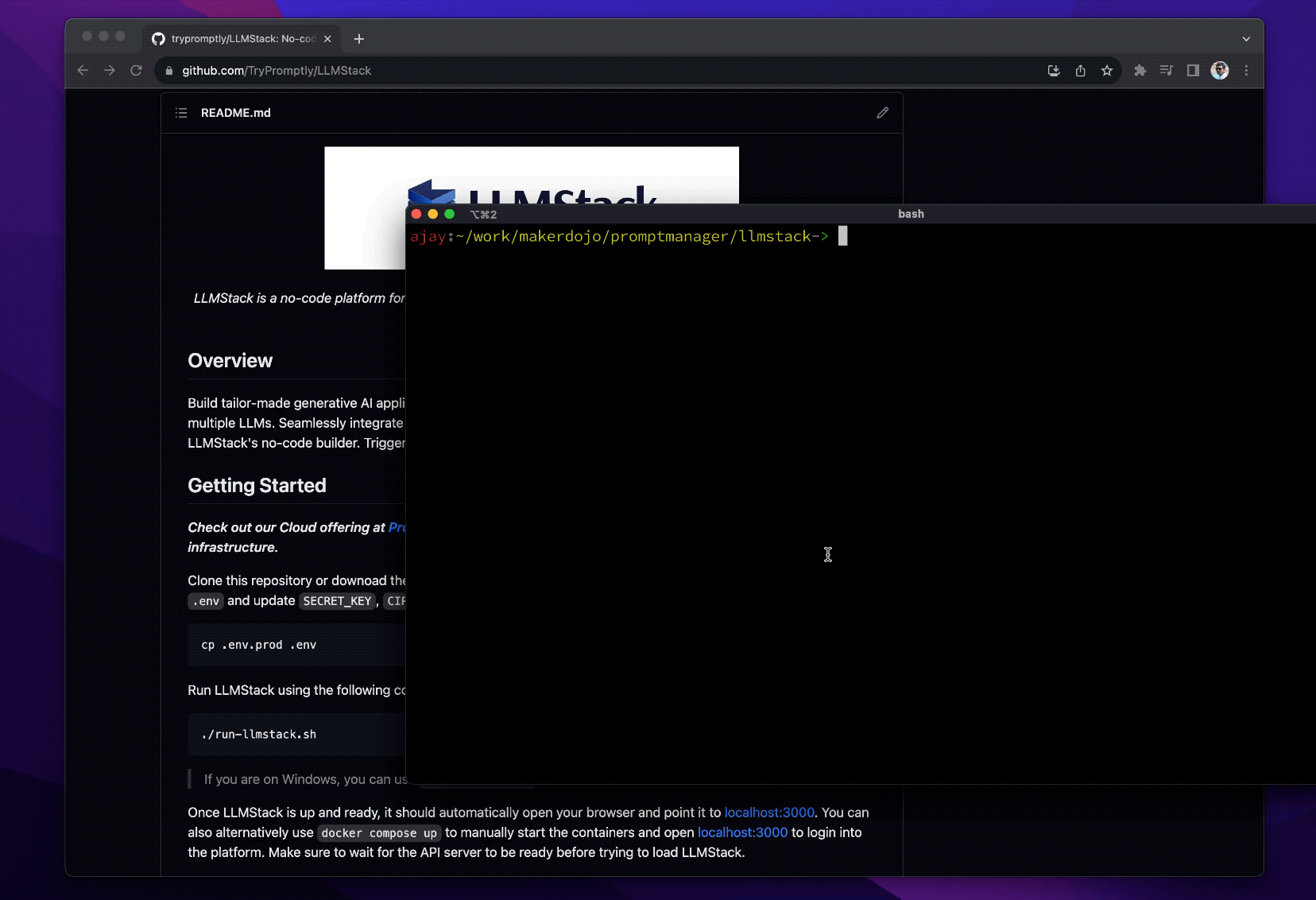

Getting Started
LLMStack deployment comes with a default admin account whose credentials are admin and promptly. Be sure to change the password from admin panel after logging in.
Features
🔗 Chain multiple models: LLMStack allows you to chain multiple LLMs together to build complex generative AI applications.
📊 Use generative AI on your Data: Import your data into your accounts and use it in AI chains. LLMStack allows importing various types (CSV, TXT, PDF, DOCX, PPTX etc.,) of data from a variety of sources (gdrive, notion, websites, direct uploads etc.,). Platform will take care of preprocessing and vectorization of your data and store it in the vector database that is provided out of the box.
🛠️ No-code builder: LLMStack comes with a no-code builder that allows you to build AI chains without any coding experience. You can chain multiple LLMs together and connect them to your data and business processes.
☁️ Deploy to the cloud or on-premise: LLMStack can be deployed to the cloud or on-premise. You can deploy it to your own infrastructure or use our cloud offering at Promptly.
🚀 API access: Apps or chatbots built with LLMStack can be accessed via HTTP API. You can also trigger your AI chains from Slack or Discord.
🏢 Multi-tenant: LLMStack is multi-tenant. You can create multiple organizations and add users to them. Users can only access the data and AI chains that belong to their organization.
What can you build with LLMStack?
Using LLMStack you can build a variety of generative AI applications, chatbots and agents. Here are some examples:
📝 Text generation: You can build apps that generate product descriptions, blog posts, news articles, tweets, emails, chat messages, etc., by using text generation models and optionally connecting your data. Check out this marketing content generator for example
🤖 Chatbots: You can build chatbots trained on your data powered by ChatGPT like Promptly Help that is embedded on Promptly website
🎨 Multimedia generation: Build complex applications that can generate text, images, videos, audio, etc. from a prompt. This story generator is an example
🗣️ Conversational AI: Build conversational AI systems that can have a conversation with a user. Check out this Harry Potter character chatbot
🔍 Search augmentation: Build search augmentation systems that can augment search results with additional information using APIs. Sharebird uses LLMStack to augment search results with AI generated answer from their content similar to Bing’s chatbot
💬 Discord and Slack bots: Apps built on LLMStack can be triggered from Slack or Discord. You can easily connect your AI chains to Slack or Discord from LLMStack’s no-code app editor. Check out our Discord server to interact with one such bot.
Administration
Login to http://localhost:3000/admin using the admin account. You can add users and assign them to organizations in the admin panel.
Documentation
Check out our documentation at llmstack.ai/docs to learn more about LLMStack.
LocalAGI
LocalAGI is a small 🤖 virtual assistant that you can run locally, made by the LocalAI author and powered by it.


AutoGPT, babyAGI, … and now LocalAGI!
Github Link - https://github.com/mudler/LocalAGI
Info
The goal is:
- Keep it simple, hackable and easy to understand
- No API keys needed, No cloud services needed, 100% Local. Tailored for Local use, however still compatible with OpenAI.
- Smart-agent/virtual assistant that can do tasks
- Small set of dependencies
- Run with Docker/Podman/Containers
- Rather than trying to do everything, provide a good starting point for other projects
Note: Be warned! It was hacked in a weekend, and it’s just an experiment to see what can be done with local LLMs.
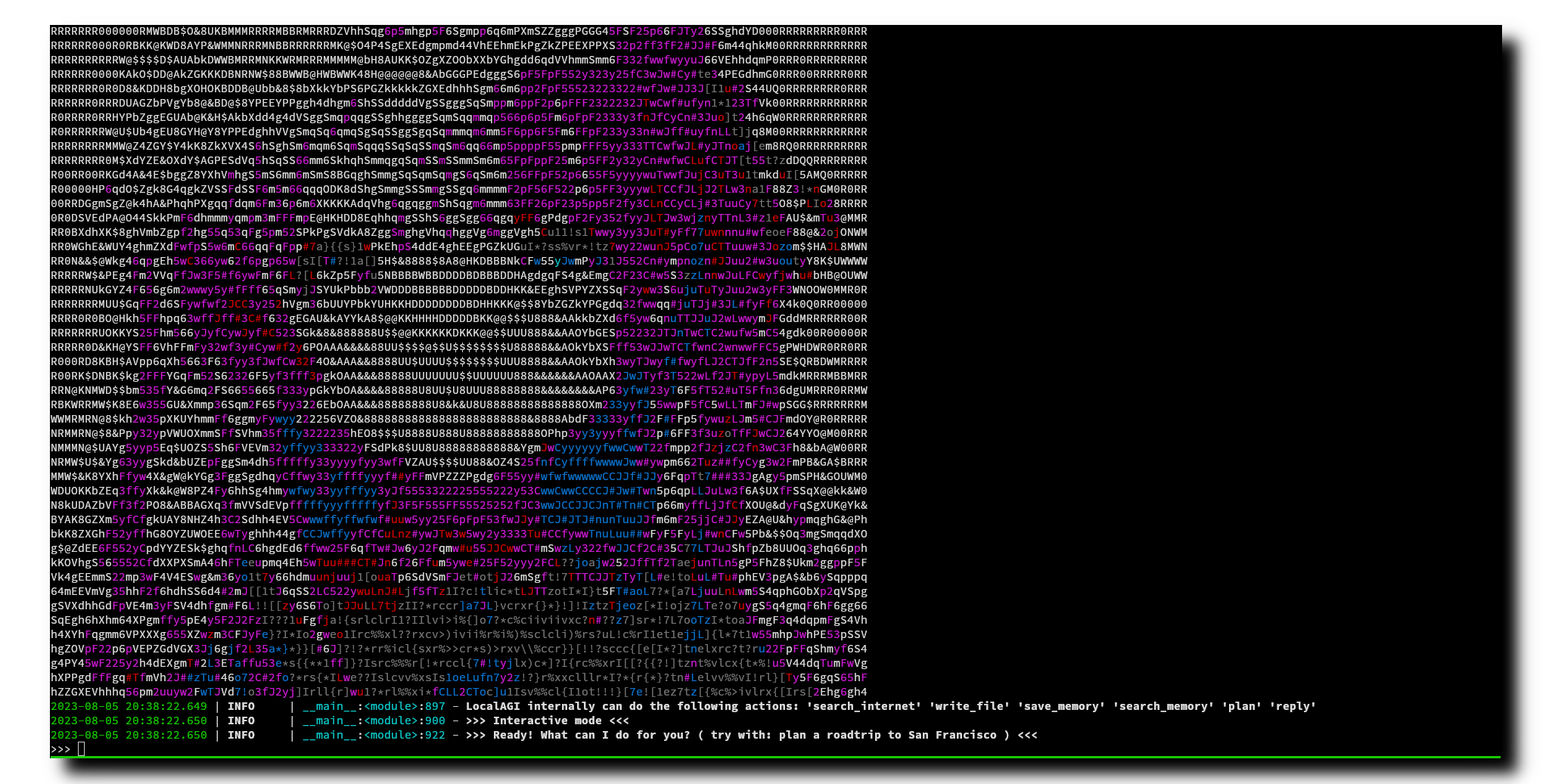

🚀 Features
- 🧠 LLM for intent detection
- 🧠 Uses functions for actions
- 📝 Write to long-term memory
- 📖 Read from long-term memory
- 🌐 Internet access for search
- :card_file_box: Write files
- 🔌 Plan steps to achieve a goal
- 🤖 Avatar creation with Stable Diffusion
- 🗨️ Conversational
- 🗣️ Voice synthesis with TTS
:book: Quick start
No frills, just run docker-compose and start chatting with your virtual assistant:
# Modify the configuration
# nano .env
docker-compose run -i --rm localagi
How to use it
By default localagi starts in interactive mode
Examples
Road trip planner by limiting searching to internet to 3 results only:
docker-compose run -i --rm localagi \
--skip-avatar \
--subtask-context \
--postprocess \
--search-results 3 \
--prompt "prepare a plan for my roadtrip to san francisco"
Limit results of planning to 3 steps:
docker-compose run -i --rm localagi \
--skip-avatar \
--subtask-context \
--postprocess \
--search-results 1 \
--prompt "do a plan for my roadtrip to san francisco" \
--plan-message "The assistant replies with a plan of 3 steps to answer the request with a list of subtasks with logical steps. The reasoning includes a self-contained, detailed and descriptive instruction to fullfill the task."
Advanced
localagi has several options in the CLI to tweak the experience:
--system-prompt is the system prompt to use. If not specified, it will use none.--prompt is the prompt to use for batch mode. If not specified, it will default to interactive mode.--interactive is the interactive mode. When used with --prompt will drop you in an interactive session after the first prompt is evaluated.--skip-avatar will skip avatar creation. Useful if you want to run it in a headless environment.--re-evaluate will re-evaluate if another action is needed or we have completed the user request.--postprocess will postprocess the reasoning for analysis.--subtask-context will include context in subtasks.--search-results is the number of search results to use.--plan-message is the message to use during planning. You can override the message for example to force a plan to have a different message.--tts-api-base is the TTS API base. Defaults to http://api:8080.--localai-api-base is the LocalAI API base. Defaults to http://api:8080.--images-api-base is the Images API base. Defaults to http://api:8080.--embeddings-api-base is the Embeddings API base. Defaults to http://api:8080.--functions-model is the functions model to use. Defaults to functions.--embeddings-model is the embeddings model to use. Defaults to all-MiniLM-L6-v2.--llm-model is the LLM model to use. Defaults to gpt-4.--tts-model is the TTS model to use. Defaults to en-us-kathleen-low.onnx.--stablediffusion-model is the Stable Diffusion model to use. Defaults to stablediffusion.--stablediffusion-prompt is the Stable Diffusion prompt to use. Defaults to DEFAULT_PROMPT.--force-action will force a specific action.--debug will enable debug mode.
Customize
To use a different model, you can see the examples in the config folder.
To select a model, modify the .env file and change the PRELOAD_MODELS_CONFIG variable to use a different configuration file.
Caveats
The “goodness” of a model has a big impact on how LocalAGI works. Currently 13b models are powerful enough to actually able to perform multi-step tasks or do more actions. However, it is quite slow when running on CPU (no big surprise here).
The context size is a limitation - you can find in the config examples to run with superhot 8k context size, but the quality is not good enough to perform complex tasks.
What is LocalAGI?
It is a dead simple experiment to show how to tie the various LocalAI functionalities to create a virtual assistant that can do tasks. It is simple on purpose, trying to be minimalistic and easy to understand and customize for everyone.
It is different from babyAGI or AutoGPT as it uses LocalAI functions - it is a from scratch attempt built on purpose to run locally with LocalAI (no API keys needed!) instead of expensive, cloud services. It sets apart from other projects as it strives to be small, and easy to fork on.
How it works?
LocalAGI just does the minimal around LocalAI functions to create a virtual assistant that can do generic tasks. It works by an endless loop of intent detection, function invocation, self-evaluation and reply generation (if it decides to reply! :)). The agent is capable of planning complex tasks by invoking multiple functions, and remember things from the conversation.
In a nutshell, it goes like this:
- Decide based on the conversation history if it needs to take an action by using functions. It uses the LLM to detect the intent from the conversation.
- if it need to take an action (e.g. “remember something from the conversation” ) or generate complex tasks ( executing a chain of functions to achieve a goal ) it invokes the functions
- it re-evaluates if it needs to do any other action
- return the result back to the LLM to generate a reply for the user
Under the hood LocalAI converts functions to llama.cpp BNF grammars. While OpenAI fine-tuned a model to reply to functions, LocalAI constrains the LLM to follow grammars. This is a much more efficient way to do it, and it is also more flexible as you can define your own functions and grammars. For learning more about this, check out the LocalAI documentation and my tweet that explains how it works under the hoods: https://twitter.com/mudler_it/status/1675524071457533953.
Agent functions
The intention of this project is to keep the agent minimal, so can be built on top of it or forked. The agent is capable of doing the following functions:
- remember something from the conversation
- recall something from the conversation
- search something from the internet
- plan a complex task by invoking multiple functions
- write files to disk
Roadmap
Development
Run docker-compose with main.py checked-out:
docker-compose run -v main.py:/app/main.py -i --rm localagi
Notes
- a 13b model is enough for doing contextualized research and search/retrieve memory
- a 30b model is enough to generate a roadmap trip plan ( so cool! )
- With superhot models looses its magic, but maybe suitable for search
- Context size is your enemy.
--postprocess some times helps, but not always
- It can be silly!
- It is slow on CPU, don’t expect
7b models to perform good, and 13b models perform better but on CPU are quite slow.
Mattermost-OpenOps
OpenOps is an open source platform for applying generative AI to workflows in secure environments.
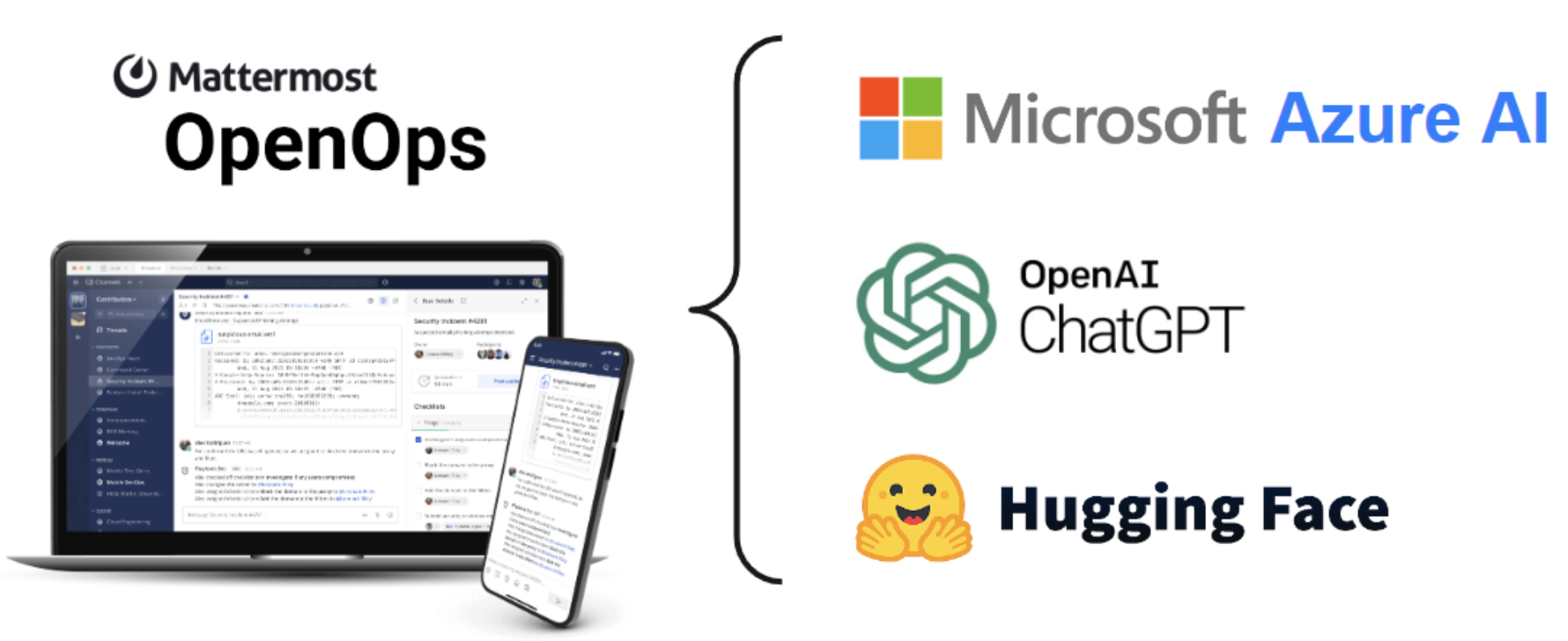

Github Link - https://github.com/mattermost/openops
- Enables AI exploration with full data control in a multi-user pilot.
- Supports broad ecosystem of AI models from OpenAI and Microsoft to open source LLMs from Hugging Face.
- Speeds development of custom security, compliance and data custody policy from early evaluation to future scale.
Unliked closed source, vendor-controlled environments where data controls cannot be audited, OpenOps provides a transparent, open source, customer-controlled platform for developing, securing and auditing AI-accelerated workflows.
Why Open Ops?
Everyone is in a race to deploy generative AI solutions, but need to do so in a responsible and safe way. OpenOps lets you run powerful models in a safe sandbox to establish the right safety protocols before rolling out to users. Here’s an example of an evaluation, implementation, and iterative rollout process:
-
Phase 1: Set up the OpenOps collaboration sandbox, a self-hosted service providing multi-user chat and integration with GenAI. (this repository)
-
Phase 2: Evaluate different GenAI providers, whether from public SaaS services like OpenAI or local open source models, based on your security and privacy requirements.
-
Phase 3: Invite select early adopters (especially colleagues focusing on trust and safety) to explore and evaluate the GenAI based on their workflows. Observe behavior, and record user feedback, and identify issues. Iterate on workflows and usage policies together in the sandbox. Consider issues such as data leakage, legal/copyright, privacy, response correctness and appropriateness as you apply AI at scale.
-
Phase 4: Set and implement policies as availability is incrementally rolled out to your wider organization.
What does OpenOps include?
Deploying the OpenOps sandbox includes the following components:
- 🏰 Mattermost Server - Open source, self-hosted alternative to Discord and Slack for strict security environments with playbooks/workflow automation, tools integration, real time 1-1 and group messaging, audio calling and screenshare.
- 📙 PostgreSQL - Database for storing private data from multi-user, chat collaboration discussions and audit history.
- 🤖 Mattermost AI plugin - Extension of Mattermost platform for AI bot and generative AI integration.
- 🦙 Open Source, Self-Hosted LLM models - Models for evaluation and use case development from Hugging Face and other sources, including GPT4All (runs on a laptop in 4.2 GB) and Falcon LLM (example of leading scaled self-hosted models). Uses LocalAI.
- 🔌🧠 (Configurable) Closed Source, Vendor-Hosted AI models - SaaS-based GenAI models from Azure AI, OpenAI, & Anthropic.
- 🔌📱 (Configurable) Mattermost Mobile and Desktop Apps - End-user apps for future production deployment.
Install
Local
Rather watch a video? 📽️ Check out our YouTube tutorial video for getting started with OpenOps: https://www.youtube.com/watch?v=20KSKBzZmik
Rather read a blog post? 📝 Check out our Mattermost blog post for getting started with OpenOps: https://mattermost.com/blog/open-source-ai-framework/
- Clone the repository:
git clone https://github.com/mattermost/openops && cd openops
- Start docker services and configure plugin
- If using OpenAI:
- Run
env backend=openai ./init.sh
- Run
./configure_openai.sh sk-<your openai key> to add your API credentials or use the Mattermost system console to configure the plugin
- If using LocalAI:
- Run
env backend=localai ./init.sh
- Run
env backend=localai ./download_model.sh to download one or supply your own gguf formatted model in the models directory.
- Access Mattermost and log in with the credentials provided in the terminal.
When you log in, you will start out in a direct message with your AI Assistant bot. Now you can start exploring AI usages.
Gitpod


- Click the above badge and start your Gitpod workspace
- You will see VSCode interface and the workspace will configure itself automatically. Wait for the services to start and for your
root login for Mattermost to be generated in the terminal
- Run
./configure_openai.sh sk-<your openai key> to add your API credentials or use the Mattermost system console to configure the plugin
- Access Mattermost and log in with the credentials supplied in the terminal.
When you log in, you will start out in a direct message with your AI Assistant bot. Now you can start exploring AI usages.
Usage
There many ways to integrate generative AI into confidential, self-hosted workplace discussions. To help you get started, here are some examples provided in OpenOps:
| Title |
Image |
Description |
| Streaming Conversation |


|
The OpenOps platform reproduces streamed replies from popular GenAI chatbots creating a sense of responsiveness and conversational engagement, while masking actual wait times. |
| Thread Summarization |


|
Use the “Summarize Thread” menu option or the /summarize command to get a summary of the thread in a Direct Message from an AI bot. AI-generated summaries can be created from private, chat-based discussions to speed information flows and decision-making while reducing the time and cost required for organizations to stay up-to-date. |
| Contextual Interrogation |
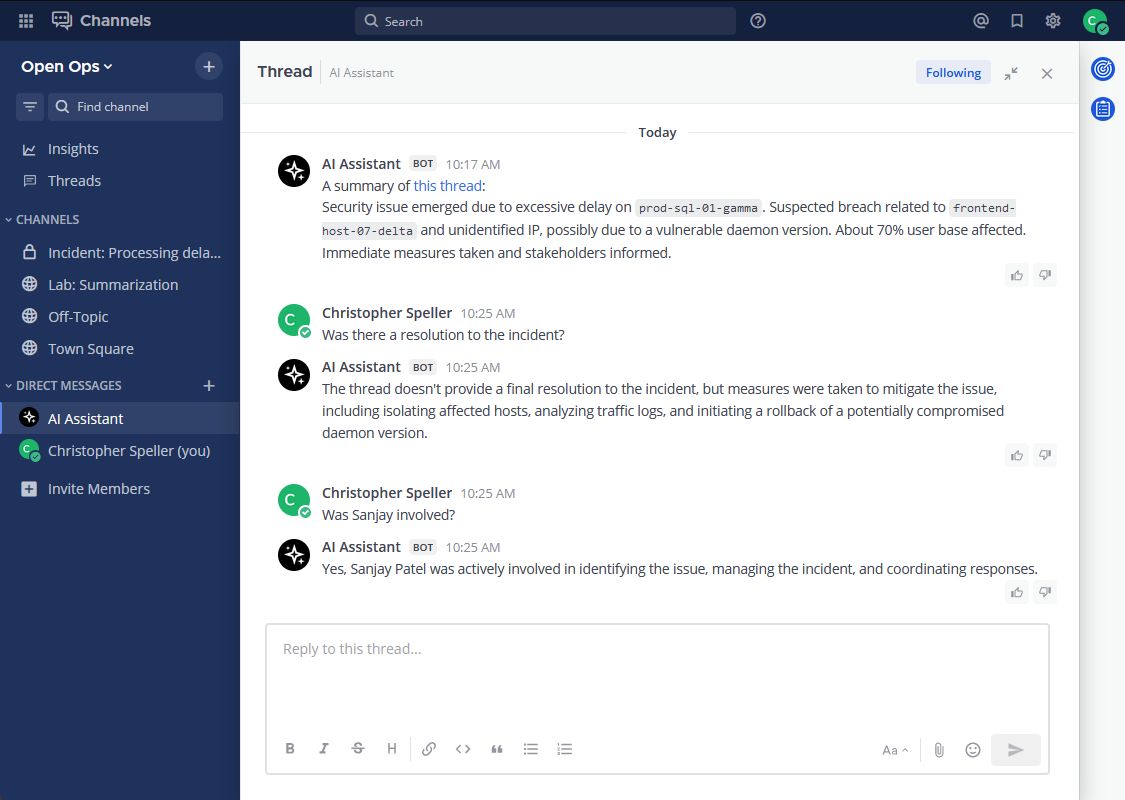

|
Users can ask follow-up questions to discussion summaries generated by AI bots to learn more about the underlying information without reviewing the raw input. |
| Meeting Summarization |


|
Create meeting summaries! Designed to work with the Mattermost Calls plugin recording feature. |
| Chat with AI Bots |


|
End users can interact with the AI bot in any discussion thread by mentioning AI bot with an @ prefix, as they would get the attention of a human user. The bot will receive the thread information as context for replying. |
| Sentiment Analysis |
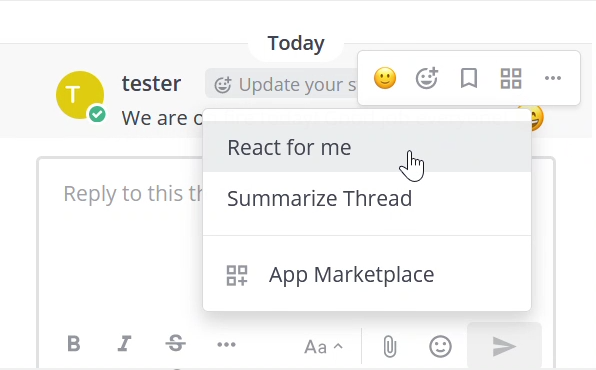

|
Use the “React for me” menu option to have the AI bot analyze the sentiment of messages use its conclusion to deliver an emoji reaction on the user’s behalf. |
| Reinforcement Learning from Human Feedback |
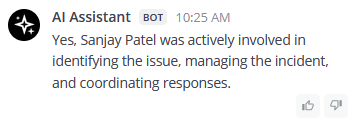

|
Bot posts are distinguished from human posts by having 👍 👎 icons available for human end users to signal whether the AI response was positive or problematic. The history of responses can be used in future to fine-tune the underlying AI models, as well as to potentially evaluate the responses of new models based on their correlation to positive and negative user ratings for past model responses. |
Mods
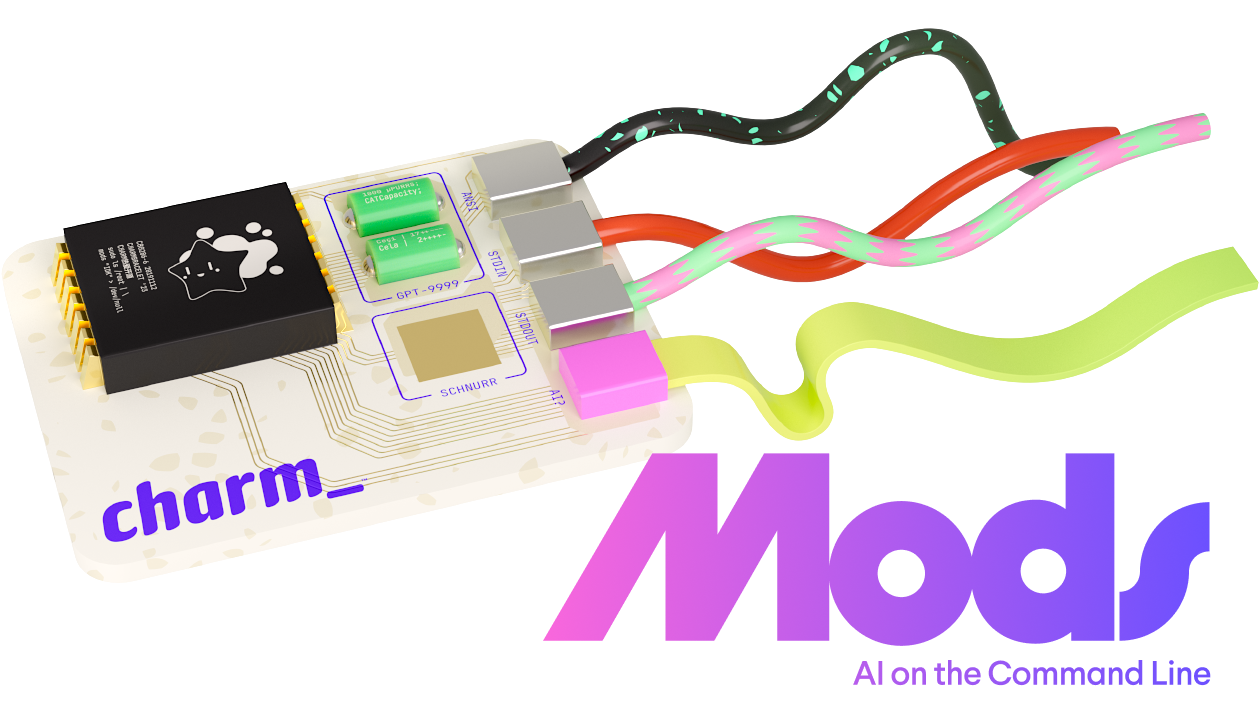
AI for the command line, built for pipelines.

LLM based AI is really good at interpreting the output of commands and
returning the results in CLI friendly text formats like Markdown. Mods is a
simple tool that makes it super easy to use AI on the command line and in your
pipelines. Mods works with OpenAI
and LocalAI
To get started, install Mods and check out some of the
examples below. Since Mods has built-in Markdown formatting, you may also want
to grab Glow to give the output some
pizzazz.
Github Link - https://github.com/charmbracelet/mods
What Can It Do?
Mods works by reading standard in and prefacing it with a prompt supplied in
the mods arguments. It sends the input text to an LLM and prints out the
result, optionally asking the LLM to format the response as Markdown. This
gives you a way to “question” the output of a command. Mods will also work on
standard in or an argument supplied prompt individually.
Installation
Mods works with OpenAI compatible endpoints. By default, Mods is configured to
support OpenAI’s official API and a LocalAI installation running on port 8080.
You can configure additional endpoints in your settings file by running
mods --settings.
LocalAI
LocalAI allows you to run a multitude of models locally. Mods works with the
GPT4ALL-J model as setup in this tutorial.
You can define more LocalAI models and endpoints with mods --settings.
Install Mods
# macOS or Linux
brew install charmbracelet/tap/mods
# Arch Linux (btw)
yay -S mods
# Debian/Ubuntu
sudo mkdir -p /etc/apt/keyrings
curl -fsSL https://repo.charm.sh/apt/gpg.key | sudo gpg --dearmor -o /etc/apt/keyrings/charm.gpg
echo "deb [signed-by=/etc/apt/keyrings/charm.gpg] https://repo.charm.sh/apt/ * *" | sudo tee /etc/apt/sources.list.d/charm.list
sudo apt update && sudo apt install mods
# Fedora/RHEL
echo '[charm]
name=Charm
baseurl=https://repo.charm.sh/yum/
enabled=1
gpgcheck=1
gpgkey=https://repo.charm.sh/yum/gpg.key' | sudo tee /etc/yum.repos.d/charm.repo
sudo yum install mods
Or, download it:
- Packages are available in Debian and RPM formats
- Binaries are available for Linux, macOS, and Windows
Or, just install it with go:
go install github.com/charmbracelet/mods@latest
Saving conversations
Conversations save automatically. They are identified by their latest prompt.
Similar to Git, conversations have a SHA-1 identifier and a title. Conversations
can be updated, maintaining their SHA-1 identifier but changing their title.

Settings
--settings
Mods lets you tune your query with a variety of settings. You can configure
Mods with mods --settings or pass the settings as environment variables
and flags.
Model
-m, --model, MODS_MODEL
Mods uses gpt-4 with OpenAI by default but you can specify any model as long
as your account has access to it or you have installed locally with LocalAI.
You can add new models to the settings with mods --settings.
You can also specify a model and an API endpoint with -m and -a
to use models not in the settings file.
Title
-t, --title
Set a custom save title for the conversation.
Continue last
-C, --continue-last
Continues the previous conversation.
Continue
-c, --continue
Continue from the last response or a given title or SHA1.
List
-l, --list
Lists all saved conversations.
Show
-s, --show
Show the saved conversation the given title or SHA1.
Delete
--delete
Deletes the saved conversation with the given title or SHA1.
-f, --format, MODS_FORMAT
Ask the LLM to format the response as markdown. You can edit the text passed to
the LLM with mods --settings then changing the format-text value.
Raw
-r, --raw, MODS_RAW
Print the raw response without syntax highlighting, even when connect to a TTY.
Max Tokens
--max-tokens, MODS_MAX_TOKENS
Max tokens tells the LLM to respond in less than this number of tokens. LLMs
are better at longer responses so values larger than 256 tend to work best.
Temperature
--temp, MODS_TEMP
Sampling temperature is a number between 0.0 and 2.0 and determines how
confident the model is in its choices. Higher values make the output more
random and lower values make it more deterministic.
TopP
--topp, MODS_TOPP
Top P is an alternative to sampling temperature. It’s a number between 0.0 and
2.0 with smaller numbers narrowing the domain from which the model will create
its response.
No Limit
--no-limit, MODS_NO_LIMIT
By default Mods attempts to size the input to the maximum size the allowed by
the model. You can potentially squeeze a few more tokens into the input by
setting this but also risk getting a max token exceeded error from the OpenAI API.
Include Prompt
-P, --prompt, MODS_INCLUDE_PROMPT
Include prompt will preface the response with the entire prompt, both standard
in and the prompt supplied by the arguments.
Include Prompt Args
-p, --prompt-args, MODS_INCLUDE_PROMPT_ARGS
Include prompt args will include only the prompt supplied by the arguments.
This can be useful if your standard in content is long and you just a want a
summary before the response.
Max Retries
--max-retries, MODS_MAX_RETRIES
The maximum number of retries to failed API calls. The retries happen with an
exponential backoff.
Fanciness
--fanciness, MODS_FANCINESS
Your desired level of fanciness.
Quiet
-q, --quiet, MODS_QUIET
Output nothing to standard err.
Reset Settings
--reset-settings
Backup your old settings file and reset everything to the defaults.
No Cache
--no-cache, MODS_NO_CACHE
Disables conversation saving.
HTTP Proxy
-x, --http-proxy, MODS_HTTP_PROXY
Use the HTTP proxy to the connect the API endpoints.
Spark
an LLM-powered autonomous agent platform


A framework for autonomous agents who can work together to accomplish tasks using LocalAI.
Github Link - https://github.com/cedriking/spark
Setup
You will need at least Node 10.
Download the repository, then install dependencies: yarn or npm install.
Rename the .env.template file at the root of the project to .env and add your secrets to it:
# the following are needed for the agent to be able to search the web:
GOOGLE_SEARCH_ENGINE_ID=... # create a custom search engine at https://cse.google.com/cse/all
GOOGLE_API_KEY=... # obtain from https://console.cloud.google.com/apis/credentials
AGENT_DELAY=... # optionally, a delay in milliseconds following every agent action
MODEL=... # any Llama.cpp LLM model
SERVER=... # optionally, a server to connect to (default http://localhost:8080)
You’ll also need to enable the Google Custom Search API for your Google Cloud account, e.g. https://console.cloud.google.com/apis/library/customsearch.googleapis.com
Running
Start the program:
or:
npm run dev [# of agents]
Interact with the agents through the console. Anything you type will be sent as a message to all agents currently.
Action errors
After spinning up a new agent, you will often see them make some mistakes which generate errors:
- Trying to use an action before they’ve asked for
help on it to know what its parameters are
- Trying to just use a raw text response instead of a correctly-formatted action (or raw text wrapping a code block which contains a valid action)
- Trying to use a multi-line parameter value without wrapping it in the multiline delimiter (
% ff9d7713-0bb0-40d4-823c-5a66de48761b)
This is a normal period of adjustment as they learn to operate themselves. They generally will learn from these mistakes and recover, although agents sometimes devolve into endless error loops and can’t figure out what the problem is. It’s highly advised to never leave an agent unattended.
Agent state
Each agent stores its state under the .store directory. Agent 1, for example, has
.store/1/memory
.store/1/goals
.store/1/notes
You can simply delete any of these things, or the whole agent folder (or the whole .store) to selectively wipe whatever state you want between runs. Otherwise, agents will pick up where you left off on restart.
A nice aspect of this is that when you want to debug a problem you ran into with a particular agent, you can delete the events in their memory subsequent to the point where the problem occurred, make changes to the code, and restart them to effectively replay that moment until you’ve fixed the bug. You can also ask an agent to implement a feature, and once they’ve done so you can restart, tell them that you’ve loaded the feature, and ask them to try it out.
Code based on ai-legion.

















